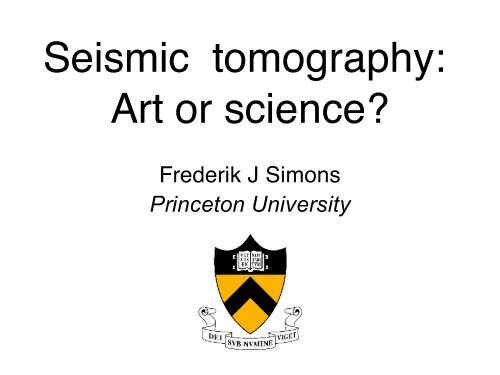Tomography Frederik Simons
Tomography Frederik Simons
Tomography Frederik Simons
You also want an ePaper? Increase the reach of your titles
YUMPU automatically turns print PDFs into web optimized ePapers that Google loves.
Seismic tomography:<br />
Art or science?<br />
<strong>Frederik</strong> J <strong>Simons</strong><br />
Princeton University
www.usgs.gov<br />
Dalton, Nature<br />
2003<br />
What’ s inside the Earth?<br />
www.glencoe.com<br />
Only seismic<br />
waves have actually<br />
been there, done that
This looks more complicated than it is;<br />
and that’ s my point.
This looks simpler than it is;<br />
and that’ s my point.
X-Ray attenuation tomography<br />
Reconstructed image:<br />
X-ray attenuation constants<br />
Projections from all angles:<br />
X-ray intensity
Seismic wavespeed tomography<br />
Projections from all angles:<br />
Waveforms and arrival times<br />
Reconstructed image:<br />
Wavespeed variations
Forward modeling of the wave field, Part I:<br />
Ray tracing, most 1-D<br />
Before After<br />
Kennett, GJI, 1995 Bullen & Bolt, 1985<br />
Buland, BSSA, 1983
Forward modeling of the wave field, Part II:<br />
Normal-mode summation, 1-D<br />
Before<br />
After<br />
Dahlen & Tromp, 1998 <strong>Simons</strong>, Lithos, 1999
Forward modeling of the wave field, Part III:<br />
Spectral-element methods, 3-D<br />
Before<br />
Komatitsch, GJI, 2002<br />
After
Non-continuous source coverage<br />
The CMT catalog of large events
Source location – (in)extricably linked<br />
Source relocation is big business.<br />
Before<br />
After<br />
Schaff, JGR, 2002
Fermat’ s Principle at Work for you<br />
Zhao, PEPI, 2004
The reference Earth: Radial models
… and at least some of it is true…<br />
Karki et al., Rev. Geoph., 2001 Jackson, 1998
Menke, 1989
Receiver coverage<br />
Picking the right continent<br />
A dense path coverage minimizes the amount<br />
of a priori information needed<br />
<strong>Simons</strong>, GJI 2002
Regularization: the Mathematics
Regularization: the Physics<br />
Such “ fat” rays sample more of the Earth and<br />
thus we need fewer of them to have a wellconstrained<br />
tomographic problem.<br />
Dahlen, GJI, 2002
Regularization: the Art<br />
Too much?<br />
Too smooth?<br />
Too little?<br />
Too rough?<br />
<strong>Simons</strong>, Lithos, 1999
How to interpret seismic models<br />
Pillet, PEPI, 1999
Demand to see the ray paths<br />
Pillet, PEPI, 1999
Shen, Nature, 1998<br />
Nature isn’ t always kind<br />
Wolfe, Nature, 1997
Seismic anisotropy<br />
Wave speeds depend on<br />
propagation direction and polarization:<br />
No surprise: elasticity maps stress and strain,<br />
and both depend on three directions
Polarization anisotropy<br />
• The particles of Love and Raleigh surface<br />
waves move in orthogonal directions<br />
• SH and SV body waves sometimes<br />
exhibit clear splitting<br />
Azimuthal anisotropy<br />
• It’ s usually very hard to separate<br />
whether the time difference arises from an<br />
anisotropic direction or an isotropic wave<br />
speed difference (aka heterogeneity)
Why is this so hard?<br />
It’ s very hard to tell whether a phase comes in early<br />
because it went through a fast patch or because it<br />
came in a fast direction –<br />
heterogeneity and anisotropy “ trade off.”
Questions to ask of the tomographer<br />
• How is the forward model computed?<br />
• What is the ray coverage?<br />
• What (sort of) damping did you use?<br />
• What does velocity estimation trade off with?<br />
• What is the grid size / the correlation length?<br />
• How are different data sets weighted?<br />
• How far is the final from the starting model?<br />
• Does the starting model have discontinuities?<br />
• How is the surface/depth parameterization<br />
• Is your sensitivity 1-D, 2-D,or 3-D?
Journey to Middle Earth, Part I:<br />
The continental lithosphere<br />
<strong>Simons</strong>, GRL, 2002<br />
Gung, Nature, 2003
Journey to Middle Earth, Part II:<br />
Subduction zones<br />
Replumaz, EPSL, 2004
Journey to Middle Earth, Part III:<br />
Deep mantle plumes<br />
Montelli, Science, 2004
110 km<br />
What does it all mean? Part I:<br />
Temperature anomalies<br />
Goes, JGR, 2002
150 km<br />
What does it all mean? Part II:<br />
Compositional anomalies<br />
ΔFe/(Fe + Mg) ΔT<br />
Perry, GJI, 2003
What does it all mean? Part III:<br />
Deformation in the mantle<br />
Fossil Contemporaneous<br />
<strong>Simons</strong>, EPSL, 2003
Conclusions<br />
• Ultimately, seismology can only tell us where,<br />
or in which direction, wave propagation is<br />
faster or slower than a reference model<br />
• The non-seismologist has to know the basics<br />
of inverse problem modeling, understand the<br />
sometimes poor constraints, and be critical<br />
• Improvements are being made: better data,<br />
better forward models, better inversions<br />
• As much as with the a posteriori<br />
interpretation, the community needs to help<br />
defining a priori acceptable starting models
More equations, for<br />
completeness

















